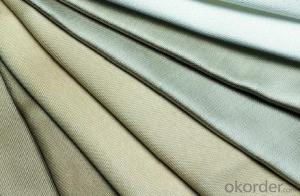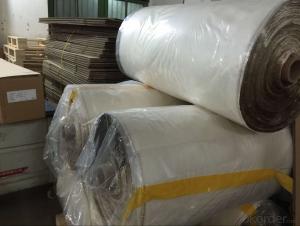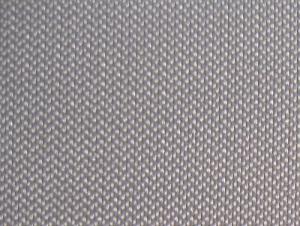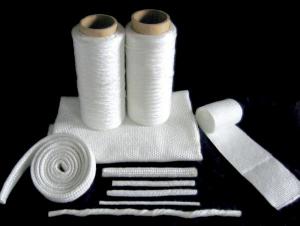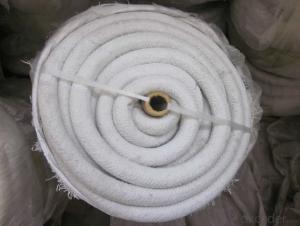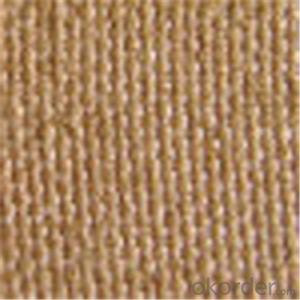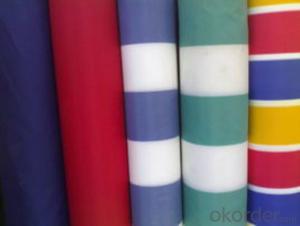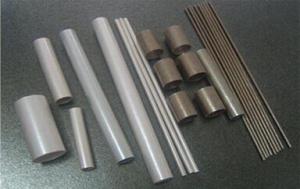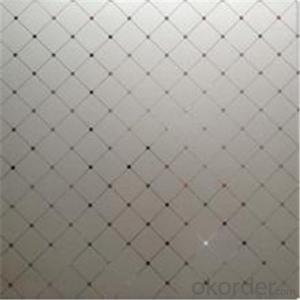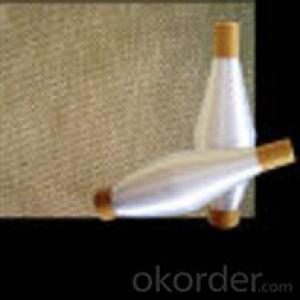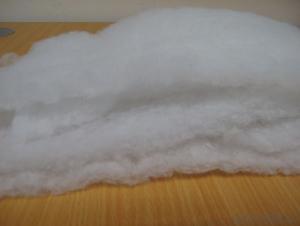36oz Silica Fiberglass Cloth Resisting 1000C for Heat Resistant
- Loading Port:
- China main port
- Payment Terms:
- TT OR LC
- Min Order Qty:
- 1000 m
- Supply Capability:
- 100000 m/month
OKorder Service Pledge
OKorder Financial Service
You Might Also Like
Product Description
Silica fiberglass is inorganic fiber that contents more than 96% of SiO2, it's resistant to high temperature, soft point 1700°C, long term service temperature 900 °C, it can work 10 minites at 1450 °C and keeps good state at 1600 °C for 15 seconds. For it's properties of chemical stability, high temperature resistance and ablation resistance, it widely used in aviationand aerospace, metallurgy, chemical, building material and fire fighting industry, etc.
Our factory is the only one that specialized manufacture silica fiberglass in China and has the production line of the whole process from marble making, fiber forming, weaving, and finish. The strength of silica fiberglass made from Na2O-B2O3-SiO2 system glass is 3-5 times higher than that from E glass. The products sold to more than 20 provinces, cities, autonomous regions and exported to foreign countries.
Silica fiberglass products are available in forms of needled mat, fabric, scrim, staple yarn, chopped strand and cord, etc.
Product Properties
1> SiO2>=96%
2> soft point nearly 1700°C, long-time working at 900°C
3> low thermal conductivity
4> good chemical stability
5> good electrical insulation
6> low thermal shrinkage
7> Non-asbestos product without pollution
8> good process performance
Product Uses
High temperature resistant, insulation and sealing material
High temperature ablation resistant material
Fireproof material (for fireproof protective clothe, fireproof curtain, fire blanket)
Dust collecting in media of high temperature gas and filtration in media of high temperature liquid
Filter for molten metal
Distinguisher, insulation material, filtration of automobile and motorcycle
Protective material for welding
Electricity insulation material
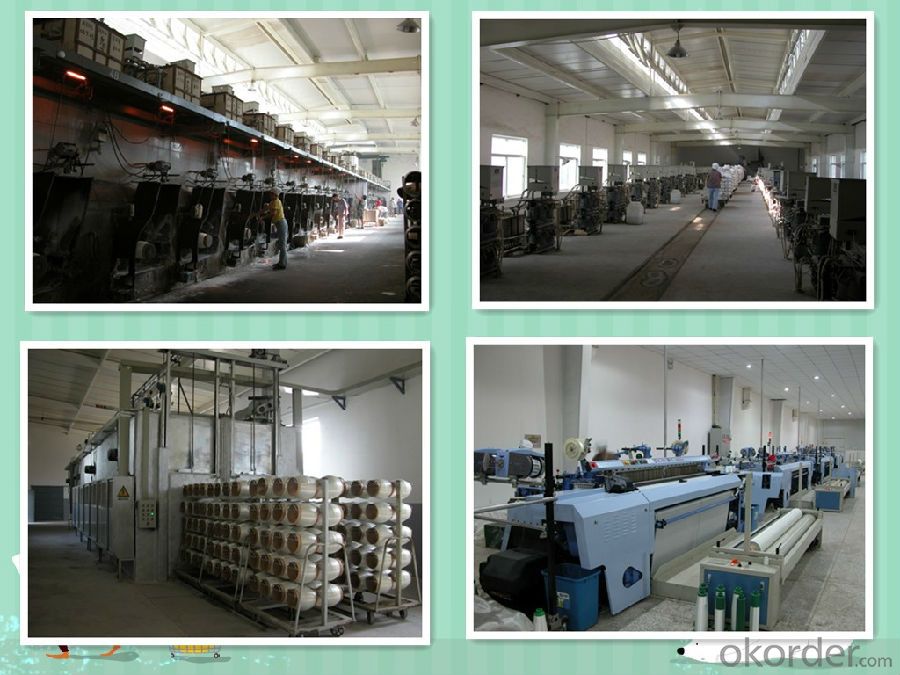

- Q:Can glass fiber textiles be used in automotive carpets?
- Yes, glass fiber textiles can be used in automotive carpets. Glass fiber textiles offer several advantages such as being lightweight, durable, and resistant to heat, chemicals, and wear. These properties make them suitable for use in automotive carpets where they need to withstand constant use, exposure to sunlight, and potential spills or stains. Glass fiber textiles can also provide insulation and soundproofing benefits, enhancing the overall comfort and performance of the automotive carpets. Additionally, glass fiber textiles can be easily molded and shaped to fit the contours of the vehicle's floor, ensuring a precise and seamless installation.
- Q:Are glass fiber textiles suitable for automotive interiors?
- Yes, glass fiber textiles are suitable for automotive interiors. Glass fiber textiles offer several advantages that make them suitable for use in automotive interiors. Firstly, glass fiber textiles are highly durable and resistant to wear and tear. This makes them ideal for use in the automotive industry where interiors are subjected to regular use and potential damage. They can withstand the rigors of everyday use, including exposure to sunlight, moisture, and temperature variations, without losing their shape or strength. Secondly, glass fiber textiles have excellent heat and sound insulation properties. They can effectively reduce the transmission of heat and noise, enhancing the comfort and driving experience for passengers. This is particularly important in automotive interiors where reducing noise levels and maintaining a comfortable temperature are desired. Furthermore, glass fiber textiles are lightweight, which is a crucial factor in the automotive industry. By using glass fiber textiles in automotive interiors, the overall weight of the vehicle can be reduced, leading to improved fuel efficiency and lower emissions. Additionally, the lightweight nature of glass fiber textiles allows for easier installation and customization of automotive interiors. Moreover, glass fiber textiles offer design flexibility. They can be molded into various shapes and patterns, allowing for creative and unique interior designs. This enables automotive manufacturers to create visually appealing and aesthetically pleasing interiors that enhance the overall look and feel of the vehicle. Lastly, glass fiber textiles are easy to clean and maintain. They are resistant to stains and can be easily wiped clean, making them suitable for automotive interiors that are often exposed to spills and dirt. In conclusion, glass fiber textiles are indeed suitable for automotive interiors due to their durability, heat and sound insulation properties, lightweight nature, design flexibility, and ease of maintenance. Automotive manufacturers can benefit from using glass fiber textiles to create high-quality, comfortable, and visually appealing interiors for their vehicles.
- Q:What are the limitations of using glass fiber textile?
- There are several limitations associated with using glass fiber textiles. Firstly, glass fibers can be brittle and prone to breakage under certain conditions. This can limit their use in applications where flexibility and durability are required. Secondly, glass fibers have a relatively high thermal conductivity, meaning they are not as effective in providing insulation compared to other materials such as mineral wool or cellulose. This can limit their use in applications where thermal insulation is crucial. Additionally, glass fibers can be irritating to the skin and respiratory system when handled or inhaled. This can pose health risks for workers who come into contact with glass fiber textiles during manufacturing or installation processes. Moreover, glass fiber textiles are relatively expensive compared to other textile materials. This can limit their use in cost-sensitive applications where alternative materials may be more economical. Lastly, glass fiber textiles are susceptible to degradation when exposed to certain chemicals or environmental conditions. This can limit their use in corrosive or harsh environments, requiring additional protective coatings or treatments. Overall, while glass fiber textiles offer several advantages such as high strength, fire resistance, and dimensional stability, their limitations in terms of brittleness, thermal conductivity, health risks, cost, and susceptibility to degradation must be considered when selecting them for specific applications.
- Q:Can glass fiber textile be used in filtration systems?
- Yes, glass fiber textile can be used in filtration systems. It is often employed as a filter media due to its excellent filtration properties, including high filtration efficiency, good chemical resistance, and high temperature resistance. Glass fiber textiles are commonly used in applications such as air filtration, water filtration, and industrial dust collection.
- Q:Are glass fiber textiles suitable for marine applications?
- Indeed, glass fiber textiles are well-suited to marine applications. Known as fiberglass textiles as well, they possess numerous characteristics that render them ideal for usage in marine settings. To begin with, glass fiber textiles exhibit a high resistance to corrosion. This is a vital attribute to consider when selecting materials for marine applications, as they are continually exposed to saltwater. This exposure can cause corrosion and degradation in many other materials. However, glass fiber textiles do not rust or corrode, rendering them highly durable in marine environments. Furthermore, glass fiber textiles boast an exceptional strength-to-weight ratio. In other words, they offer significant strength and structural integrity while remaining lightweight. This quality is particularly important for marine applications, as it allows for the construction of robust and long-lasting structures without adding excessive weight to the vessel or equipment. Additionally, glass fiber textiles possess remarkable dimensional stability. This means that they can maintain their shape and size even when subjected to fluctuating temperatures and humidity levels. This aspect is crucial for marine applications, as vessels and equipment often encounter diverse environmental conditions. Moreover, glass fiber textiles are non-conductive and possess excellent electrical insulation properties. Consequently, they are well-suited for marine applications that require protection of electrical components and wiring from water and moisture. Lastly, glass fiber textiles are relatively easy to mold and shape, allowing for flexibility in design and construction. This versatility makes them suitable for a wide array of marine applications, including boat hulls, decks, insulation, and protective covers. In summary, glass fiber textiles offer a range of advantageous properties that make them highly suitable for marine applications. Their resistance to corrosion, impressive strength-to-weight ratio, dimensional stability, electrical insulation properties, and flexibility in design establish them as a reliable choice for diverse marine structures and equipment.
- Q:Can glass fiber textiles be used in the production of curtains and blinds?
- Yes, glass fiber textiles can be used in the production of curtains and blinds. Glass fiber textiles, also known as fiberglass fabrics, are made from fine fibers of glass that are woven together to create a durable and lightweight material. These textiles have excellent thermal insulation properties, as well as being fire-resistant and resistant to chemicals and moisture. When used in curtains and blinds, glass fiber textiles can provide several benefits. They can effectively block out sunlight, reducing glare and heat from entering a room. Glass fiber curtains and blinds can also provide privacy, as they are often made with a tight weave that restricts visibility from the outside. Additionally, glass fiber textiles are known for their durability, making them suitable for long-term use in curtains and blinds. They are resistant to fading, tearing, and other forms of wear and tear, ensuring that they maintain their functionality and appearance over time. Moreover, glass fiber textiles are easy to clean and maintain. They can be easily wiped down or cleaned with mild detergent, making them suitable for environments where cleanliness is important, such as kitchens and bathrooms. In summary, glass fiber textiles can be a viable option for the production of curtains and blinds. They offer thermal insulation, privacy, durability, and easy maintenance, making them a practical choice for both residential and commercial applications.
- Q:Can glass fiber textiles be used in filtration?
- Glass fiber textiles have the capability to be used in filtration. Renowned for their resistance to high temperatures, chemicals, and impressive filtration properties, glass fiber textiles possess a vast surface area and a delicate pore structure that enables them to efficiently capture and eliminate particles from both liquids and gases. These textiles are extensively utilized in a range of filtration applications, including air filters, water filters, and industrial filtration systems. Notably, they excel at removing minute particles such as dust, pollen, bacteria, and other impurities. Furthermore, glass fiber textiles can be effortlessly cleaned and reused, rendering them an economical and environmentally friendly choice for filtration purposes.
- Q:What are the different reinforcement options for glass fiber textile?
- Depending on the desired strength and performance characteristics, glass fiber textiles have several reinforcement options available. 1. Woven Fabric: The most commonly used reinforcement option, woven fabrics interlace glass fibers in patterns such as plain or twill weaves. They offer good strength and stiffness, and find extensive use in composites, concrete reinforcements, and insulation materials. 2. Non-Woven Fabric: Unlike woven fabrics, non-woven fabrics bond or felt glass fibers together without weaving. This option provides excellent uniformity and dimensional stability, making it suitable for filtration media, geotextiles, and thermal insulation. 3. Chopped Strand Mat (CSM): CSM is formed by randomly aligning short glass fibers in a binder material matrix. It offers good strength, easy handling, and the ability to mold into complex shapes. It is commonly utilized in boat building, automotive parts, and corrosion-resistant tanks. 4. Continuous Roving: Continuous roving is a bundle of untwisted glass fibers that provides high tensile strength. It is specifically used for applications requiring exceptional strength, like wind turbine blades, pressure vessels, and aerospace components. 5. Knitted Fabric: Knitted fabrics interlock loops of glass fibers, granting them flexibility and conformability. This makes them suitable for applications that necessitate stretchability, such as sports equipment, medical products, and clothing. 6. Multiaxial Fabrics: Multiaxial fabrics arrange glass fibers in multiple layers or orientations, including unidirectional, biaxial, or triaxial layers. This option offers tailored mechanical properties, improved strength in specific directions, and enhanced impact resistance. It is commonly employed in aerospace structures, automotive parts, and high-performance sports equipment. Manufacturers and designers have a range of choices with these reinforcement options, allowing them to select the most suitable option based on specific requirements for strength, flexibility, conformability, and other performance characteristics.
- Q:Is glass fiber textile resistant to chemicals?
- Yes, glass fiber textile is generally resistant to chemicals. Glass fiber is known for its excellent chemical resistance, making it suitable for various applications where exposure to chemicals is common. It is highly resistant to acids, alkalis, solvents, and other corrosive substances. This resistance is due to the inherent properties of glass, such as its inertness and non-reactivity. Additionally, glass fiber textile materials can be further enhanced with specialized coatings or treatments to provide even greater chemical resistance. However, it is important to note that the specific level of chemical resistance may vary depending on the type and composition of the glass fiber textile, as well as the specific chemicals involved. Therefore, it is always recommended to consult the manufacturer's specifications or conduct appropriate testing to ensure suitability for a particular chemical environment.
- Q:Can glass fiber textiles be used in filtration systems?
- Yes, glass fiber textiles can be used in filtration systems. Glass fibers have a high filtration efficiency, as they can trap and remove small particles from liquids or gases. They are commonly used in various filtration applications such as air filters, water filters, and industrial filtration systems. The properties of glass fibers, including their durability, resistance to chemicals, and ability to withstand high temperatures, make them suitable for filtration purposes.
1. Manufacturer Overview |
|
|---|---|
| Location | |
| Year Established | |
| Annual Output Value | |
| Main Markets | |
| Company Certifications | |
2. Manufacturer Certificates |
|
|---|---|
| a) Certification Name | |
| Range | |
| Reference | |
| Validity Period | |
3. Manufacturer Capability |
|
|---|---|
| a)Trade Capacity | |
| Nearest Port | |
| Export Percentage | |
| No.of Employees in Trade Department | |
| Language Spoken: | |
| b)Factory Information | |
| Factory Size: | |
| No. of Production Lines | |
| Contract Manufacturing | |
| Product Price Range | |
Send your message to us
36oz Silica Fiberglass Cloth Resisting 1000C for Heat Resistant
- Loading Port:
- China main port
- Payment Terms:
- TT OR LC
- Min Order Qty:
- 1000 m
- Supply Capability:
- 100000 m/month
OKorder Service Pledge
OKorder Financial Service
Similar products
New products
Hot products
Hot Searches
